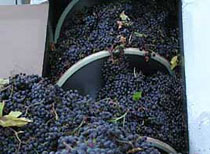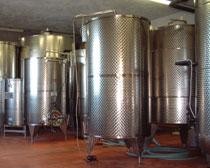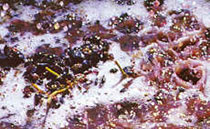Barbera Project - The Pressing and Fermentation process

Fabio Vinciguerra in person tells us of the pressing and fermentation processes, his words give the idea of the passion and enthusiasm behind this project:
 It has been an excellent harvest. The climate has been extremely favourable and the barbera grapes have matured on the vines to their optimal level, characterized by a balanced acidity and a rich sugar content, the latter representing an essential element during fermentation. The attentive cares in the vineyards throughout the year have determined an excellent quality of the grapes and this important result will surely render all work in the winery a lot easier. As soon as the harvest is completed, work begins to pick up in the winery. The least of time intervals has to pass between the moment in which the grapes are picked and the pressing. This is so in order to avoid even the minimum fermentation process which might take place in the baskets as the result of the accidental squashing of the grapes. Borce, despite the hard work in the vineyards, is extremely busy and full of energy and moves around the winery checking every single piece of equipment. He too, just like all of us, is eager to see the result of an entire year of hard labour! The grapes are placed in the destemmer and the pressed most is sent to tank n. 19 on which a chalk board reads ‘Vigna Vecchia 2006’.
It has been an excellent harvest. The climate has been extremely favourable and the barbera grapes have matured on the vines to their optimal level, characterized by a balanced acidity and a rich sugar content, the latter representing an essential element during fermentation. The attentive cares in the vineyards throughout the year have determined an excellent quality of the grapes and this important result will surely render all work in the winery a lot easier. As soon as the harvest is completed, work begins to pick up in the winery. The least of time intervals has to pass between the moment in which the grapes are picked and the pressing. This is so in order to avoid even the minimum fermentation process which might take place in the baskets as the result of the accidental squashing of the grapes. Borce, despite the hard work in the vineyards, is extremely busy and full of energy and moves around the winery checking every single piece of equipment. He too, just like all of us, is eager to see the result of an entire year of hard labour! The grapes are placed in the destemmer and the pressed most is sent to tank n. 19 on which a chalk board reads ‘Vigna Vecchia 2006’.
 Now it’s the enologist’s turn whose philosophy, totally in line with ours, is to treat the wine with the utmost delicacy and to work on it the least possible. The aim is to not alter in any way that invisible thread which, in all our wines, must tie the primal fruit to what will be inside a bottle: a small quantity of sulphur dioxide is added; it has an antiseptic and selective function by limiting the development of ‘bad’ bacteria or ‘wild’ yeasts thus letting the ‘good’ yeasts to start a good fermentation process. What the old producers referred to as ‘the miracle of nature’ finally begins: the solid parts of the grapes (marcs and seeds) are not separated from the most and are left to macerate with it. By doing so, the coloring substances, the tannins and acids are gradually transferred to the most, determining the organoleptic characteristics of the wine.
Now it’s the enologist’s turn whose philosophy, totally in line with ours, is to treat the wine with the utmost delicacy and to work on it the least possible. The aim is to not alter in any way that invisible thread which, in all our wines, must tie the primal fruit to what will be inside a bottle: a small quantity of sulphur dioxide is added; it has an antiseptic and selective function by limiting the development of ‘bad’ bacteria or ‘wild’ yeasts thus letting the ‘good’ yeasts to start a good fermentation process. What the old producers referred to as ‘the miracle of nature’ finally begins: the solid parts of the grapes (marcs and seeds) are not separated from the most and are left to macerate with it. By doing so, the coloring substances, the tannins and acids are gradually transferred to the most, determining the organoleptic characteristics of the wine.
 The most is left to ferment at a controlled temperature of 26° C (if the temperature would exceed 37° C the alcoholic fermentation would halt). Immediately the yeasts start the fermentation process where the sugars are transformed into alcohol and carbon dioxide. The heat resulting from the fermentation and the increasing alcohol content contribute to the process of extraction of those substances from the marcs and the seeds which are essential in the making of a structured red wine of great quality. Our enologist confirms what had already been discussed during the first days of September: the maceration process will continue for 12 days. Right after, the solid part of the grapes will be finally separated and the life of the Barbera ‘Vigna Vecchia 2006’ will continue with the aging in big wood casks. The first chapters have been written, but the history of ‘Vigna Vecchia’ 2006 is just at its beginning!
The most is left to ferment at a controlled temperature of 26° C (if the temperature would exceed 37° C the alcoholic fermentation would halt). Immediately the yeasts start the fermentation process where the sugars are transformed into alcohol and carbon dioxide. The heat resulting from the fermentation and the increasing alcohol content contribute to the process of extraction of those substances from the marcs and the seeds which are essential in the making of a structured red wine of great quality. Our enologist confirms what had already been discussed during the first days of September: the maceration process will continue for 12 days. Right after, the solid part of the grapes will be finally separated and the life of the Barbera ‘Vigna Vecchia 2006’ will continue with the aging in big wood casks. The first chapters have been written, but the history of ‘Vigna Vecchia’ 2006 is just at its beginning!








